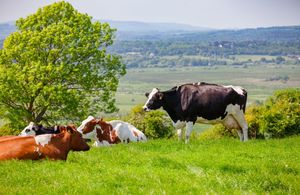Sustainable Farming Incentive (SFI)
The Sustainable Farming Incentive (SFI) will pay farmers to adopt and maintain sustainable farming practices that can protect and enhance the natural environment alongside food production, and also support farm productivity (including by improving animal health and welfare, optimising the use of inputs and making better use of natural resources)
The accelerated roll out of the Sustainable Farming Incentive – a key part of the Government’s Environmental Land Management schemes – will provide farmers with a diverse range of paid actions to manage hedgerows for wildlife, plant nectar-rich wildflowers and manage crop pests without the use of insecticides.
These incentives will make food production more resilient and efficient over the longer term whilst contributing towards the UK’s environmental goals on carbon, biodiversity, water quality and net zero. Together this will safeguard the long-term prosperity of the farming industry and protect the environment for future generations.
Six additional standards will be added to the Sustainable Farming Incentive this year, including:
- hedgerows standard
- integrated pest management standard
- nutrient management standard
- arable and horticultural land standard
- improved grassland standard
- low input grassland standard
They build on the three existing standards to improve soil health and moorlands introduced in 2022 – which nearly 1,900 farmers already have in agreements.
Countryside Stewardship Scheme (CSS)
Countryside Stewardship will pay for more targeted actions relating to specific locations, features and habitats. There will be an extra incentive through CS Plus for land managers to join up across local areas to deliver bigger and better results
The Government has also detailed what farmers will be paid to deliver through an enhanced version of the Countryside Stewardship scheme, which will see around 30 additional actions available to farmers by the end of 2024. The expansion builds on the more than 250 actions farmers can take at present with the scheme seeing a 94% increase in uptake since 2020 and is now part of thousands of farm businesses. The next round of Countryside Stewardship Higher-Tier will open in February, with Mid-Tier following in March.
Countryside Stewardship Plus will reward farmers for taking coordinated action, working with neighbouring farms and landowners to support climate and nature aims. It will deliver the same high environmental ambition previously planned for Local Nature Recovery, including managing floodplain meadows to reduce flood risk and improve biodiversity, restoring and maintaining peatland for carbon capture and storage, and enhancing and managing woodland to mitigate against drought and enhance its resilience to climate change.
The scheme will also be improved so farmers benefit from greater flexibility over when they can apply and how they manage their agreements, with improved access for tenant farmers and increased access to Higher Tier options and agreements.
Elsewhere, following high demand last year, Defra has confirmed it will open applications for the second round of the Landscape Recovery scheme in the spring to support ambitious large-scale nature recovery projects, focusing on net zero, protected sites and habitat creation. This could include projects creating and enhancing woodlands, peatland, nature reserves and protected sites such as ancient woodlands, wetlands and salt marshes.
They involve groups of land managers and tenant farmers, working together to deliver a range of environmental benefits across farmed and rural landscapes. 22 projects began last year aiming to restore nearly 700km of rivers and protect and enhance 263 species.
Further details on the new standards and payment rates being rolled for the Sustainable Farming Incentive as well as information on the future roll out of Countryside Stewardship Plus from 2024 will be available on gov.uk
Landscape Recovery
Landscape Recovery will pay for bespoke, longer-term, larger scale projects to enhance the natural environment.
Countryside Stewardship (CS) and CS Plus
The schemes will collectively pay farmers and land managers to deliver, alongside food production, significant and important outcomes for the climate and environment that can only be delivered by farmers and other land managers in the wider countryside. These include:
- creating and restoring a broad range of wildlife-rich habitat, as well as continuing to protect habitat already managed under our existing agri-environment schemes
- improving water quality, by reducing nitrogen, phosphorus and sediment pollution from agricultural activities, building on our existing Catchment Sensitive Farming approach
- increasing resilience to flooding and drought through nature-based solutions such as natural flood management
- creating more new woodlands and treescapes to increase tree and woodland cover, and encouraging management of existing woodlands, including to increase their resilience to pests and diseases
- reducing carbon emissions, storing carbon and increasing resilience to climate change, for example through management of soils, water, peatland and trees



